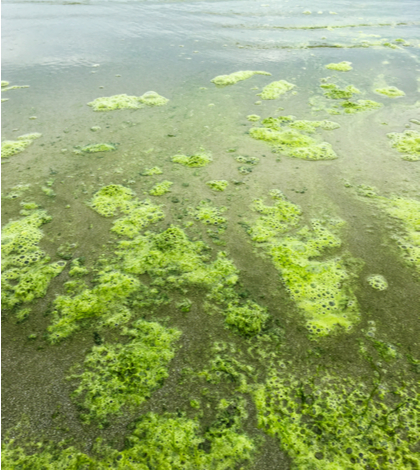With schools already dismissed for the year – or soon will be – and the summer recreational season about to swing into full gear, the California State Water Resources Control Board has issued a reminder to the public to be aware of harmful algal blooms (HABs). The seasonal blooms can pose health risks to both humans and animals.
HABs are essentials components of freshwater ecosystems. But conditions that favor their growth – warm temperatures, stagnant water flows, excessive nutrient inputs from agricultural and commercial sites – can cause the organisms that cause HABS (algae and cyanobacteria) to multiply rapidly and cause “bloom.” Though the organisms have existed for billions of years, when blooms occur they can produce toxins and are then referred to as harmful algal blooms.
Children and dogs are most likely to be affected by HABs because of their smaller body size. Children traditionally play in the water longer than adults and can inadvertently swallow the water. Dogs are especially susceptible because they swallow more water while swimming and activities like retrieving a ball from the water, and are less deterred by unsightly, smelly water which is common with algal blooms.
HABs can be a variety of colors such as green, white, red or brown and may look like thick paint floating on the water. They may have a grainy, sawdust-like appearance of individual colonies. Whereas green algae and other non-toxic water plants that are not thought to pose potential hazards to health often exist in waterways and are easily confused by the general public, any suspicion of HABs is reason to avoid any body of water.
The California Water Boards advise people to practice healthy water habits while enjoying the summer at local lakes, rivers and streams:
- Heed all instructions on posted advisories if present
- Avoid algae and scum in the water and on the shore
- Keep an eye on children and all pets, especially dogs
- Wash yourself, your family and your pets with clean water after water play
- Don’t drink the water or use it for cooking
- If you catch fish, throw away guts and clean fillets with tap water or bottled water before cooking
- Avoid eating shellfish if you think a HAB is present
- If you think a HAB is present, do not let pets and other animals go into or drink the water, or eat scum/algal accumulations on the shore
People can help prevent blooms in our waters with the following measures:
- Use phosphate-free dishwasher detergent
- Properly maintain septic systems
- Be conservative with use of water, fertilizers and pesticides on your lawn, garden or small farm
- Plant or maintain native vegetation around the water’s edge
- Pick up pet waste
Be aware that toxins can be present in water bodies even when a bloom is not visible. To verify if a bloom has been reported, contact the water body’s manager or visit the HAB Reports Map at: https://mywaterquality.ca.gov/habs/where/freshwater_events.html. To report blooms, go to: https://mywaterquality.ca.gov/habs/do/index.html#how.
 California Water News Daily Your Source For Water News in California
California Water News Daily Your Source For Water News in California


